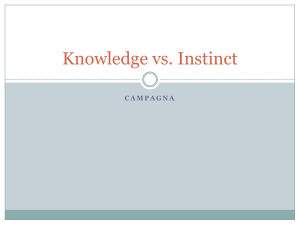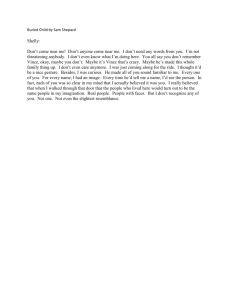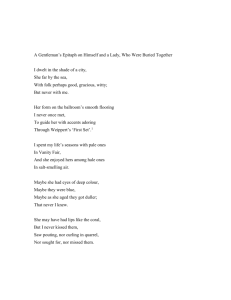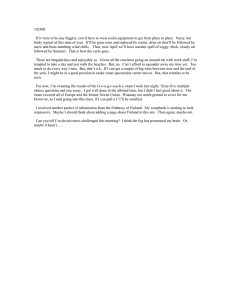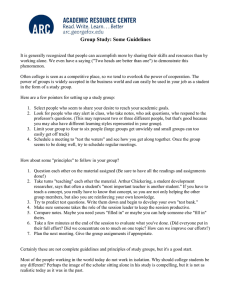J The Well-Practiced
advertisement
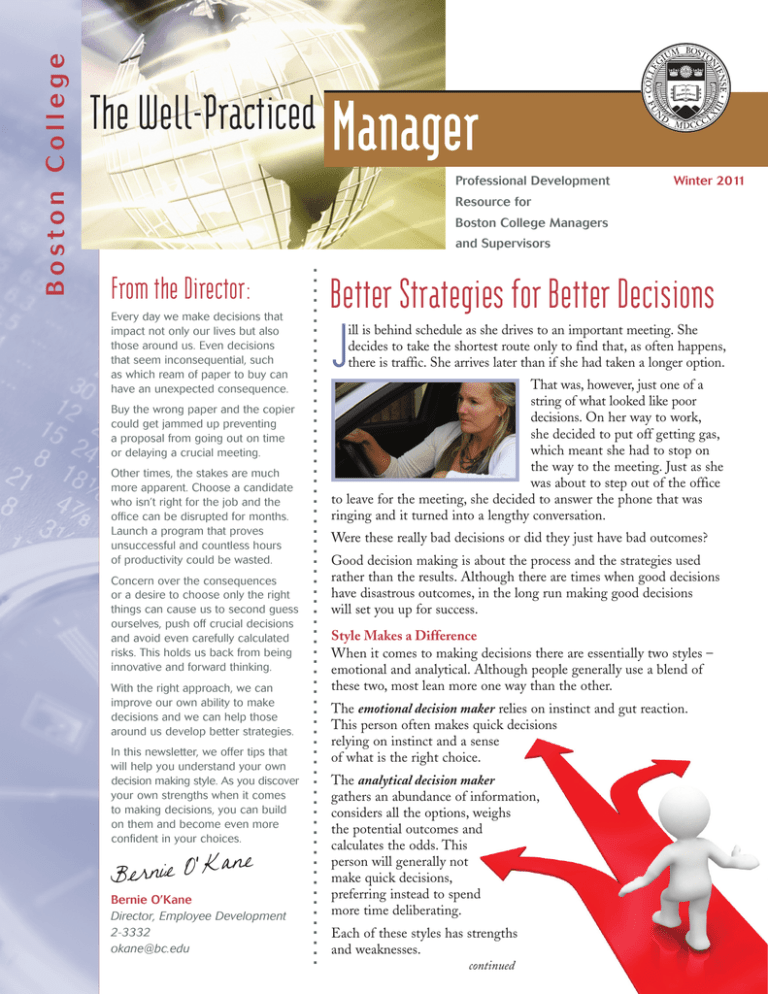
Boston College The Well-Practiced Manager Professional Development Winter 2011 Resource for Boston College Managers and Supervisors ■ From the Director: ■ ■ ■ Every day we make decisions that impact not only our lives but also those around us. Even decisions that seem inconsequential, such as which ream of paper to buy can have an unexpected consequence. ■ ■ ■ ■ ■ ■ ■ ■ ■ Buy the wrong paper and the copier could get jammed up preventing a proposal from going out on time or delaying a crucial meeting. ■ ■ ■ ■ ■ ■ Other times, the stakes are much more apparent. Choose a candidate who isn’t right for the job and the office can be disrupted for months. Launch a program that proves unsuccessful and countless hours of productivity could be wasted. ■ ■ ■ ■ ■ ■ ■ ■ With the right approach, we can improve our own ability to make decisions and we can help those around us develop better strategies. ■ ■ ■ ■ ■ ane K ’ O ie n r e B Bernie O’Kane Director, Employee Development 2-3332 okane@bc.edu That was, however, just one of a string of what looked like poor decisions. On her way to work, she decided to put off getting gas, which meant she had to stop on the way to the meeting. Just as she was about to step out of the office to leave for the meeting, she decided to answer the phone that was ringing and it turned into a lengthy conversation. Were these really bad decisions or did they just have bad outcomes? Good decision making is about the process and the strategies used rather than the results. Although there are times when good decisions have disastrous outcomes, in the long run making good decisions will set you up for success. ■ ■ ■ ■ ■ ■ ■ ■ ■ ■ ■ ■ ■ In this newsletter, we offer tips that will help you understand your own decision making style. As you discover your own strengths when it comes to making decisions, you can build on them and become even more confident in your choices. J ill is behind schedule as she drives to an important meeting. She decides to take the shortest route only to find that, as often happens, there is traffic. She arrives later than if she had taken a longer option. ■ ■ Concern over the consequences or a desire to choose only the right things can cause us to second guess ourselves, push off crucial decisions and avoid even carefully calculated risks. This holds us back from being innovative and forward thinking. Better Strategies for Better Decisions ■ ■ ■ Style Makes a Difference When it comes to making decisions there are essentially two styles – emotional and analytical. Although people generally use a blend of these two, most lean more one way than the other. The emotional decision maker relies on instinct and gut reaction. This person often makes quick decisions relying on instinct and a sense of what is the right choice. ■ ■ ■ ■ ■ ■ ■ ■ ■ ■ ■ ■ ■ ■ ■ The analytical decision maker gathers an abundance of information, considers all the options, weighs the potential outcomes and calculates the odds. This person will generally not make quick decisions, preferring instead to spend more time deliberating. ■ ■ ■ ■ ■ Each of these styles has strengths and weaknesses. continued 2 Deciding to Decide Sometimes you just get stuck. Maybe the consequences of making the wrong decision are overwhelming. Maybe you have to choose between two really good options or maybe they seem equally awful. It is important to recognize what is behind the hesitation. Do you have enough information? Do you need to know more about the situation or the potential result? Perhaps the issue is an emotional road block. Are you worried about having to deliver the news or that someone will be unhappy with your decision? Once you recognize what is bothering you, you can take steps to mitigate your concerns and then make the decision. ■ ■ ■ ■ ■ ■ ■ ■ ■ ■ ■ ■ ■ ■ ■ ■ ■ ■ ■ ■ ■ ■ ■ Sometimes gut instinct is the best way to go. Spending too much time analyzing a problem can delay a decision and data does not always point to the best choice. Emotions, however, can get in the way. Making a hasty decision could lead to a mistake. The emotional decision maker may also get bogged down trying to sort out conflicting emotions. These are times when a little analysis could help. What is your style? Once you understand how you make decisions, you can choose the best option for a particular situation. Defining the Decision Making a good decision starts with clearly defining what you are trying to decide. The question may seem obvious: Do I stop to get gas now? Yes – the tank is low and if I don’t, I could run out. No – I don’t have time. But, if the question is reframed, the answer may change: When should I stop to get gas? This applies to launching new programs, hiring people and buying office supplies. Write down the question. Is there another way to frame it? Next, consider the options. If there is time and the stakes are high, it can be helpful to write them down. This is the time to brainstorm. Start with the obvious alternatives, but don’t limit yourself. Think about creative, maybe even absurd options. Don’t rule things out at this stage, even absurd ideas could lead to rational options that weren’t immediately obvious. Once you have all the options, start thinking about the advantages and disadvantages. It is usually impossible to know for sure what will happen since there are so many unpredictable factors, but what are the most likely outcomes? Employee Development Office Department of Human Resources More Hall 315 617.552.8532 employee.development@bc.edu • www.bc.edu/ed Strategies Applied Jill knew that the short route often has traffic, but she was traveling before rush hour and the road should have been clear. If she made the same decision the next day, she would likely have made the meeting on time. Jill answered the phone because she had been waiting for a call about an ongoing project. If she hadn’t taken the call, her department would have missed an important deadline. Beware of the Pitfalls There are many things that can interfere with making a good decision. Knowing them will help you avoid them. ■ A lack of information There are many factors that will affect the outcome of your decision. Knowing as much as possible about other factors will help you discern the most likely outcome. Consulting others can help fill in gaps. ■ Mood Our emotions, both positive and negative, can influence our decisions. If you are happy, you are more likely to anticipate a positive outcome whether or not it is more likely. The opposite is true if you are sad or angry. ? ■ Personal bias This is harder to discern because it requires looking at things from an outsider’s perspective. Biases may have a subtle effect of causing us to disregard good alternatives without giving them fair consideration. Ask yourself why you object to a certain option, especially if others support it. continued 3 Group Decision or Solo? There are times when it makes sense to include several people in making a decision, such as when the outcome will affect an entire department. At the same time, including extra people can muddle and delay the process. Better Decisions Consider: ■ Will those involved be happier with the outcome if they have a say? ■ Is there time to get people involved? ■ Will the quality of the decision be better if more are involved? ■ How will those involved react if things do not go their way? ■ Is there a way to involve people in the discussion without having them make the decision? Resources: Think Twice by Michael J. Mauboussin Harvard Business Press How We Decide by Jonah Lehrer Mariner Books Blunder: Why Smart People Make Bad Decisions by Zachary Shore Bloomsbury USA Editorial Services provided by Jennifer Powell, The Excellent Writers Group, excellentwriters.com Graphic Design by Tania Fine Helhoski, BirdDesign, www.birddesignstudio.com
